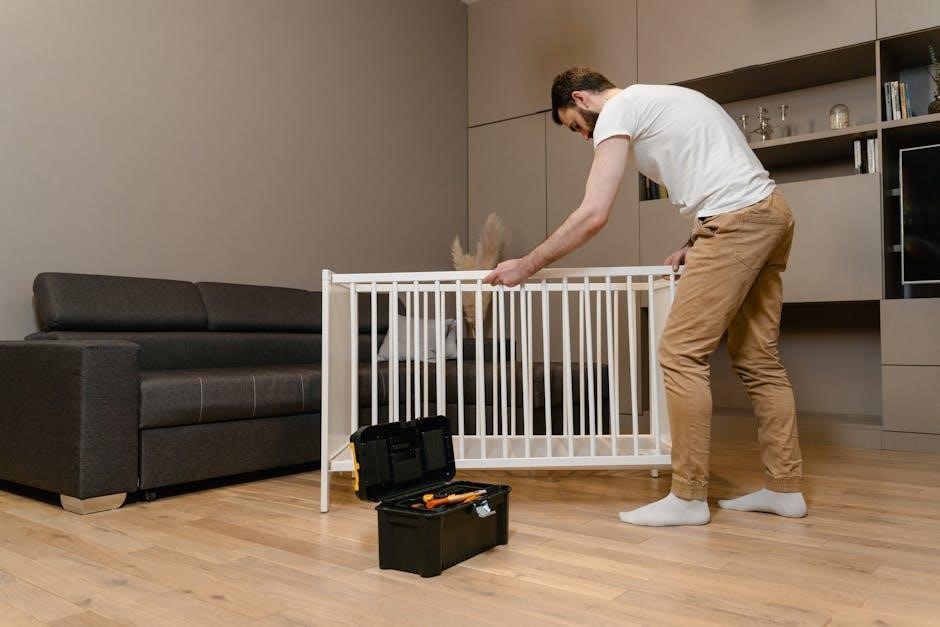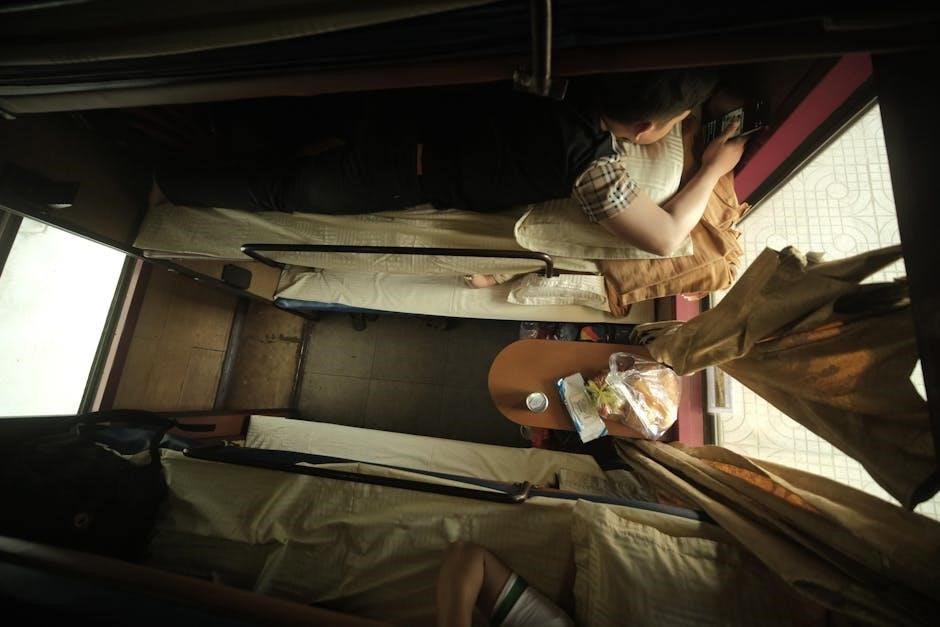Assembling a bunk bed can be straightforward if you follow detailed instructions. Safety, proper tools, and a step-by-step guide are essential for a stable and secure structure.
1.1 Overview of Bunk Bed Assembly
Assembling a bunk bed involves constructing two bed frames, one above the other, using prefabricated parts. The process typically includes attaching side rails, building frames, installing slats, and assembling leg structures. Instructions often provide numbered steps, diagrams, and safety guidelines to ensure stability and security. Most bunk beds require basic tools like Allen wrenches and screwdrivers. While the task can be completed by one person, having a second pair of hands is recommended for easier handling of larger components. Proper assembly ensures safety, durability, and functionality of the bunk bed, making it essential to follow the instructions carefully.
1.2 Importance of Following Instructions
Following the assembly instructions is crucial for ensuring the bunk bed is stable and safe to use. Proper assembly prevents structural weaknesses and potential hazards, such as collapsing or tipping. Instructions provide a clear sequence of steps to avoid common assembly mistakes. By adhering to the guide, you ensure all parts are correctly aligned and securely fastened. This not only enhances the durability of the bed but also protects users from accidents. Skipping or misinterpreting steps can lead to unsafe conditions, especially for children. Always read the manual thoroughly before starting to guarantee a safe and successful assembly process.
1.3 Safety Considerations
Safety is paramount when assembling a bunk bed. Ensure the bed is placed on a level floor to prevent tipping and avoid positioning it near windows or blinds. Guardrails should always be installed to prevent falls, especially for the upper bunk. Weight limits must be respected to maintain structural integrity. Keep children away during assembly and ensure all tools are safely stored. Regular inspections are necessary to detect any loose connections or wear. Additionally, adherence to all safety guidelines in the manual helps create a secure environment for users, reducing the risk of accidents and ensuring long-term stability of the bunk bed.

Preparation for Assembly
Select a level floor location with enough space around the bunk bed for easy access. Measure the area to confirm the bed will fit comfortably.
2.1 Tools and Materials Needed
To assemble a bunk bed, gather essential tools like an Allen wrench, screwdriver, and pliers. Ensure all parts, including slats, side rails, and bolts, are included in the package. Check for any missing items before starting. A level floor and adequate workspace are crucial for efficient assembly. Refer to the manual for specific tools recommended by the manufacturer. Organize all components to avoid confusion. Having a second person assist can simplify the process, especially for larger bunk beds. Double-checking the inventory ensures a smooth assembly experience without delays. Proper preparation saves time and reduces the risk of errors during assembly.
2.2 Choosing the Right Location
Selecting the right location for your bunk bed is crucial for safety and functionality. Ensure the area has a level floor to prevent the bed from wobbling. Measure the space to confirm the bunk bed fits comfortably, leaving enough room for easy access. Avoid placing the bed near windows or doors to minimize hazards. Position the bed so the guardrail faces a wall to prevent entrapment. Consider the room layout to ensure the bunk bed does not obstruct pathways or doors. Proper placement enhances stability and ensures a safe sleeping environment for users. Always follow the manufacturer’s recommendations for placement.
2.3 Unpacking and Organizing Parts
Unpacking and organizing all parts is the first step in a smooth assembly process. Carefully open the boxes and lay out each component to ensure nothing is damaged or missing. Separate hardware like screws, bolts, and Allen wrenches. Label or group similar parts together to avoid confusion later. Check the inventory list provided in the manual to confirm all items are present. Organizing parts by size or type can save time and reduce frustration. A clean, well-organized workspace will help you follow the instructions more efficiently. Always double-check the contents before starting assembly to prevent delays. This step ensures everything is ready for assembly.

Understanding the Assembly Manual
Understanding the assembly manual is crucial for successful bunk bed assembly. It contains detailed steps, diagrams, and safety tips to guide you through the process effectively.
3.1 Reading the PDF Instructions
Reading the PDF instructions thoroughly is essential before starting assembly. These documents typically include detailed diagrams, numbered steps, and safety guidelines. Ensure you have all parts listed and understand each step to avoid errors. Pay attention to symbols and notes, as they often highlight critical assembly points. PDF manuals are designed to be clear and user-friendly, making the assembly process smoother. Always refer back to the instructions if unsure about any component or step. A well-prepared approach ensures a safe and sturdy bunk bed setup.
3.2 Interpreting Diagrams and Illustrations
Diagrams and illustrations in bunk bed assembly instructions are crucial for understanding the process visually. They often depict parts, their relationships, and step-by-step actions; Look for labels on components and arrows indicating assembly directions. Color-coded or highlighted sections may emphasize critical steps or safety points. Cross-reference diagrams with written instructions to ensure clarity. Pay attention to scale and proportions to avoid misaligning parts. If symbols or abbreviations are unclear, refer to any provided legends or keys. These visual aids help prevent errors and ensure a safe, sturdy build. Take time to study each diagram carefully before proceeding to the next step.
3.3 Following Numbered Steps

Numbered steps in bunk bed assembly instructions provide a clear, sequential guide to ensure accuracy and safety. Each step outlines specific actions, such as attaching parts or tightening bolts. Read each step thoroughly before executing to avoid confusion. Pay attention to any warnings or emphasis, as these highlight critical points. Use diagrams to cross-reference steps and confirm proper part alignment. Completing each step in order prevents structural issues and ensures stability. Double-check your work after each numbered section to catch errors early. Following the sequence carefully guarantees a safe and sturdy bunk bed assembly, minimizing risks and ensuring long-term durability.

Step-by-Step Assembly Process
The step-by-step assembly process ensures a systematic approach to building your bunk bed. Begin with attaching side rails, then construct the bed frames, and install slats for support. Assemble leg structures and secure all connections. Follow the sequence carefully to maintain stability and safety. Refer to diagrams for visual guidance, and tighten all bolts firmly. Double-check each step to ensure accuracy and prevent structural weaknesses. This methodical process guarantees a sturdy and secure bunk bed, ready for use while adhering to safety standards.
4.1 Attaching Side Rails
Attaching side rails is a critical first step in bunk bed assembly. Locate the side rails (C) and align them with the bottom frame. Use the provided bolts to secure the rails tightly, ensuring they are evenly spaced. Refer to the PDF manual for specific diagrams. Tighten all connections firmly to prevent wobbling. Make sure the rails are level and properly aligned with the frame for stability. Double-check the bolts before proceeding to the next step. This ensures a solid foundation for the entire bunk bed structure and guarantees safety for the users. Proper alignment is essential for weight distribution and durability. Always follow the sequence outlined in the instructions to avoid errors.
4.2 Building the Bed Frames
Constructing the bed frames involves attaching the headboards and footboards to the side rails. Ensure the frame is square by measuring diagonally. Secure the joints using the provided bolts, tightening firmly. Align the pre-drilled holes carefully to avoid misalignment. Use an Allen wrench for bolts and a screwdriver for screws. Double-check the frame’s stability before adding slats. Properly fitted frames ensure the bunk bed’s structural integrity and safety. Follow the PDF guide’s diagrams for precise assembly; Avoid over-tightening, which may damage the wood. Once the frames are built, they form the base for the mattresses and upper bunk. Ensure all connections are secure for maximum stability.
4.3 Installing Slats
Slats provide essential support for the mattresses and ensure even weight distribution. Begin by unpacking and organizing the slats according to the assembly manual. Place the slats evenly across the bed frame, aligning them with the pre-drilled holes. Secure each slat using the provided screws, tightening firmly to avoid any wobbling. Ensure proper spacing between slats for optimal support. Once all slats are installed, double-check their alignment and tightness. A sturdy slat system is crucial for the safety and comfort of the bunk bed. Refer to the PDF guide for specific slat placement and spacing requirements. Proper installation ensures a stable and durable sleeping surface.
4.4 Assembling the Leg Structures
Assembling the leg structures is a critical step for stability; Begin by attaching the legs to the bed frames using the bolts and washers provided. Ensure the legs are evenly spaced and aligned with the frame’s pre-drilled holes. Tighten the bolts securely, but avoid overtightening. For bunk beds with multiple levels, attach the support legs between the two frames to enhance stability. Use a level to confirm the structure is even. Once the legs are in place, stand the bunk bed upright and double-check all connections. Properly assembled legs ensure the bunk bed remains sturdy and safe for use. Refer to the manual for specific hardware requirements.
4.5 Final Assembly and Tightening
After assembling all components, perform a final review. Ensure all bolts, screws, and connections are secure and properly tightened. Check that the bed frames, slats, and leg structures are firmly attached. Use an Allen wrench or screwdriver to tighten any loose joints. Verify that guardrails are securely fastened, especially if they were optional. Double-check the alignment of the upper and lower bunks to ensure they are level and evenly spaced. Finally, test the bunk bed by gently rocking it to confirm stability. A thorough final assembly ensures safety and durability, making the bunk bed ready for use.

Safety Tips and Precautions
Ensure guardrails are securely attached and placed against walls to prevent entrapment. Always check weight limits and avoid exceeding them. Place the bunk bed on a level floor and keep the surrounding area clear. Regularly inspect for loose connections or damage. Never modify the structure without manufacturer approval to maintain safety standards.
5.1 General Safety Guidelines
When assembling and using a bunk bed, prioritize safety to prevent accidents. Ensure the bed is placed on a level floor and away from windows to minimize fall risks. Always attach guardrails securely, especially on the side facing away from the wall, to prevent entrapment. Keep the area around the bunk bed clear to allow easy access and avoid tripping hazards. Regularly inspect the structure for loose connections or damage. Teach children to climb carefully and avoid jumping on the bed. Follow the manufacturer’s weight limits to ensure stability and safety for all users.
5.2 Weight Limits and Load Capacity
Adhering to the manufacturer’s weight limits is crucial for safety. Most bunk beds specify a maximum weight capacity, typically ranging between 200 to 400 pounds per bed. Ensure that the combined weight of occupants does not exceed this limit to prevent structural failure. Check the assembly manual for specific guidelines, as some models may have varying capacities for upper and lower bunks. Overloading can lead to instability and potential collapse, posing serious safety risks. Always communicate these limits to users to ensure safe and enjoyable use of the bunk bed.
5.3 Placing the Bunk Bed Against a Wall
Positioning the bunk bed against a wall enhances stability and safety. Ensure the bed is placed on a level floor to prevent tilting. Secure the bed frame to the wall using brackets or screws provided in the assembly kit to avoid accidental movement. This is especially important for the upper bunk to minimize the risk of tipping.
Always place the side with the guardrail against the wall to prevent entrapment. Double-check the manual for specific wall-mounting instructions, as some models may require additional hardware. Proper placement ensures a safe and secure sleeping environment for users.

Common Mistakes to Avoid
Avoid tightening all bolts prematurely, as this can misalign parts. Use Allen wrenches for final tightening after ensuring all components are correctly positioned and aligned.
6.1 Incorrect Part Assembly
One of the most common mistakes is incorrectly assembling parts, such as mismatching side rails or improperly attaching slats. Always double-check labels and diagrams to ensure components are used correctly. Misaligned parts can lead to instability, so verify each connection before tightening bolts. Pay attention to left and right designations, as mixing these can cause structural issues. Guardrails, for example, should be placed on the outer side of the bed. If unsure, refer back to the manual or manufacturer’s instructions. Taking time to align parts properly ensures safety and durability of the bunk bed. Use Allen wrenches for final tightening only after all parts are securely in place.
6.2 Ignoring Weight Restrictions
Ignoring weight restrictions is a critical mistake that can compromise the safety and stability of the bunk bed. Always check the manufacturer’s guidelines for maximum load capacity. Exceeding these limits can lead to structural instability or even collapse. Weight restrictions apply to both the upper and lower bunks, so ensure they are not overloaded with mattresses, bedding, or people. Pay attention to the distributed weight limits for each part of the bed. Failure to adhere to these guidelines can result in accidents, injuries, or damage to the bed frame. Refer to the manual for specific weight recommendations to ensure safe usage and longevity of the bunk bed.
6.3 Improper Placement of Guardrails
Improper placement of guardrails is a common mistake that can lead to safety hazards. Guardrails must be securely attached to prevent gaps where a child could slip through or get trapped. If the bunk bed is placed against a wall, ensure the guardrail faces inward to avoid entrapment between the bed and the wall. Always follow the manufacturer’s instructions for guardrail installation, as improper placement can compromise the bed’s safety features. Double-check that all bolts and screws are tightened firmly to maintain the guardrail’s stability. Neglecting this step can result in accidents, especially for children, making it crucial to prioritize proper guardrail placement during assembly.

Troubleshooting Assembly Issues
Common issues include misaligned parts, loose connections, or missing pieces. Re-examine instructions, double-check all bolts, and ensure proper alignment for a stable and secure structure.
7.1 Identifying Missing Parts
Before starting assembly, thoroughly check all components against the provided parts list. Missing items like bolts, screws, or rails can halt progress, so verify each piece is present. If something is missing, contact the manufacturer or supplier promptly for a replacement. Using substitute parts is not recommended, as they may not fit properly and could compromise the bed’s safety and stability. Ensure every component is accounted for to avoid delays and ensure a secure build.
7.2 Resolving Alignment Problems
Alignment issues during assembly can be frustrating but are often easy to fix. Ensure the floor is level and use shims if necessary to balance the structure. Check that all frame components are properly aligned with pre-drilled holes and connectors. If parts don’t fit, verify they’re in the correct orientation. Tightening bolts too early can cause misalignment, so assemble major sections loosely and adjust before final tightening. Consult the manual or manufacturer’s support if persistent alignment problems arise. Proper alignment is crucial for stability and safety, so take the time to address any issues thoroughly.
7.3 Fixing Loose Connections
Loose connections can compromise the safety and stability of your bunk bed. Regularly inspect all bolts, screws, and joints to ensure they are tightly secured. Use a wrench or screwdriver to tighten any loose parts. If a connection remains loose, check for missing or misaligned washers or spacers. Re-tighten all hardware after the initial assembly and periodically thereafter. For added stability, apply threadlocker to bolts if recommended by the manufacturer. Addressing loose connections promptly ensures the bed remains sturdy and safe for use, preventing potential accidents or structural damage over time.

Maintenance and Upkeep
Regularly clean and inspect the bunk bed to ensure durability. Dust surfaces, vacuum mattresses, and check for wear or loose parts, addressing issues promptly for safety.
8.1 Cleaning the Bunk Bed
Cleaning the bunk bed regularly is essential for maintaining hygiene and durability. Use a soft cloth and mild detergent to wipe down surfaces, avoiding harsh chemicals. Vacuum mattresses and surrounding areas to remove dust and allergens. For wooden frames, a damp cloth can be used, but ensure the wood is dry afterward to prevent warping. Metal parts can be cleaned with a gentle metal polish. Always test cleaning products on a small, inconspicuous area first to avoid damage. Regular cleaning helps prevent the buildup of dirt and extends the lifespan of the bed. Keep the area around the bed tidy to ensure safety and comfort.
8.2 Regular Inspections
Regular inspections are crucial to ensure the bunk bed remains safe and stable. Check all bolts, screws, and connections to confirm they are tight and secure. Inspect the wooden slats and frame for cracks or damage. Look for any signs of wear, such as loosened joints or wobbly parts. If you find any issues, address them immediately by tightening or replacing the affected components; Pay special attention to guardrails and ladder stability to prevent accidents. Inspections should be conducted every few months, especially in high-usage environments. A well-maintained bunk bed ensures long-term durability and safety for users.

Additional Resources
Download assembly manuals from manufacturer websites or online marketplaces. Join furniture assembly forums for tips and troubleshooting. Visit official product pages for detailed guides and support.
9.1 Downloading Assembly Manuals
To ensure a smooth assembly process, download the official bunk bed assembly manual from the manufacturer’s website or product page. Search for the specific model name and “assembly instructions PDF” to find the correct document. Many brands offer free downloadable manuals in PDF format, which include detailed step-by-step guides, diagrams, and tool lists. Verify the manual matches your bunk bed model to avoid confusion. If unavailable on the official site, check online marketplaces or support forums where users often share manuals. Always download from trusted sources to ensure accuracy and safety.
9.2 Online Communities for Support
Online forums and communities provide valuable support for bunk bed assembly. Platforms like Reddit’s DIY or furniture assembly groups offer advice and troubleshooting tips. Users often share their experiences, highlighting common mistakes and solutions. Websites dedicated to woodworking or home improvement also feature discussions on bunk bed projects. Additionally, manufacturer-specific forums can connect you with experts or others who have assembled the same model. These communities are a great resource for clarifying instructions or addressing unique challenges, ensuring your bunk bed is assembled safely and correctly. Active participation can enhance your assembly experience and provide peace of mind.



Be the first to reply